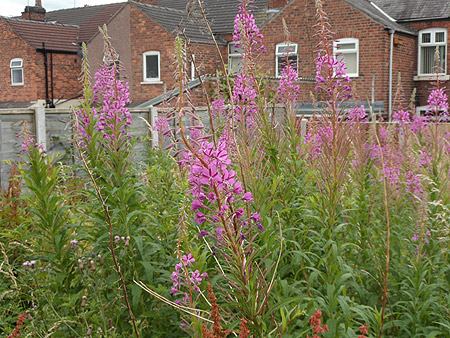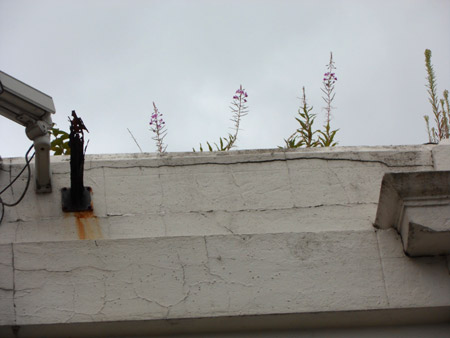
| HOME |
| NERVE |
| REVIEWS |
| ARCHIVE |
| EVENTS |
| LINKS |
| ABOUT US |
| CONTRIBUTORS |
| BACK ISSUES |
| CONTACT US |
 |
 |
Fireweed*
By Sandra Gibson
Photographs by Geoff Edwards
On the Beaten Track
August 2012
Every man in Crewe who did not work in Rolls Royce making cars worked at Crewe Works, making steam trains. This was the Fifties: the twilight of steam; the birth of rock ‘n’ roll - which interested me rather more. Because my father made trains (a whole one by himself every day, in my child’s mind) we were entitled to subsidised rail travel and every summer we went to Blackpool in a corridored carriage divided into rooms each with its own door. Every family bagged one, swiftly netted their luggage and threw themselves down on the unyielding seats. And it always, always, worked out numerically. Somehow. Whenever I think of this I remember the sound of the steam and the hot dusty smell of the upholstery and the leather strap that operated the downward slamming window and the old-fashioned black and white photographs of resorts as yet unvisited and the feeling of resentment if any stranger opened the door to share our space.
Part of the nostalgia I feel for those days - unappreciated then by a little girl in green fluorescent socks, chastely in love with Phil Everly - comes from the memories of the countryside that bordered the track: fields of Friesian cows, station buildings with hollyhock sentries, mixed hedges punctuated with purple buddleia cones, toy-sized farmyards, drifts of Fireweed….
And I didn’t know then, as I scanned the sky after Preston for the first glimpse of the Blackpool Tower, that the metal track, laid by a strong man from Ireland, so that my father’s train could take us to the seaside, had caused that ribbon of landscape peculiar to rail routes, had produced those clouds of magenta and silver thistledown: Fireweed.
Fireweed: that great pioneer; that coloniser of traumatised land.
In eighteenth century Britain, Fireweed, or Rosebay Willowherb, was a rare species. The Industrial Revolution, through its tumultuous disturbing of the earth to extract raw materials, build towns, dig canals, create rail networks and generally cause havoc, also caused the proliferation of this plant, whose seeds (80,000 per plant) lie dormant in the soil for many years, until conditions are right for germination. Forest fires, the disturbance of the land, and more recently, bomb attacks, all create the correct environment - the opening up of the soil to light. And that’s why we associate Fireweed with canal banks, railway cuttings and bomb craters.
And hope.
It’s a special plant** in other ways too: the leaf veins are uniquely circular and Fireweed can tolerate conditions in Arctic as well as temperate zones. Every part of the plant has been used one way or another. The raw stem helps heal cuts or boils; in Alaska Fireweed may be found in sweets, syrups, jellies and ice cream; in Russia it became a tea substitute exported to Western Europe as Kapor tea. The seeds have silky hairs to aid wind dispersal. If this isn’t enough, the roots also spread underground. It has, in addition, the ability to colonise land that has been polluted by oil spillage and that’s enough to guarantee distinction to any plant. No wonder it is the floral emblem of Yukon and was voted county flower of London in 2002.
But no description, no wooden botanical drawing, can do justice to the responsive poetic delicacy of this plant, which catches light and goes in after the bad guys have done their worst.
I wonder what Fireweed is doing on the roof of the Adelphi, though.
To read other Fireweed columns click here
*Also known as Rose Bay Willow Herb, the prolific wild flower called Fireweed, five feet tall with spikes of magenta flowers, cheers the hearts of those whose cityscape has become a bomb site or whose buildings have been cleared by machine. The dormant seeds spring to life after destructive events such as forest or man-made fires, hence the name, Fireweed. This occasional column will celebrate the persistence of wildlife in urban conditions.